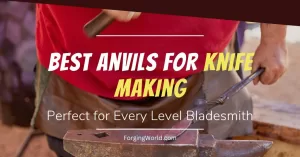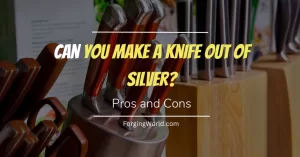So you just started forging, and you’re wondering if you can use those old parts of the engine for making knives. You want to recycle stuff; the material looks good, but before you start, you just want to check how good that steel really is…
What about things like bearing races, bolts, coil springs, and wheel spindles? Can we use them, or it’s not worth bothering?
Some would say no, and that mystery metal is a fool’s game. “Get yourself decent metal, so you know exactly what you’re working with!”
But it’s not that simple, and today we’re “melting” it all down and explaining why.
In short, engine parts will function pretty well for making knives, but it’s much easier to work with a known object and known heat treat. They’re far better for artists than tool makers as they don’t need to overly worry about if it was good steel, only if it’s suitable aesthetically.
I think a lot of us have grappled with the “scrapyard tool steel” subject. My mechanic used to give me coil springs and leaf springs whenever I wanted them. One time he had so many steel parts piled up I drove it to the scrap metal dealer for him after cherry-picking all the good stuff out of the pile and passed some of it on to me for decorative knives.
This functioned reasonably well, and I was able to have some fun using it, but I used “store-bought” tool steel as time went on.
Anyway, let’s dive into dissecting this subject so you can get a better understanding of engine steel and how and when to use it!
You Can Use Bearing Races (52100) for Knife-Making
If you’re in the process of making forge with bearings races, you want to know if this material is going to warp the original machined shape.
The experiments I have done have shown me that the more forging that takes place, the better the performance of the finished knife in the form of cross-sectional reduction. So based on this, I need to say that it doesn’t matter whether a blade was formed out of a bearing or a race but how much forging, at the proper (low) temp was done to reach the finished blade. All coupled with proven heat-treating processes.
You might’ve been told that bearing races cannot be used for knives as this material has a memory and will warp when heat-treated back to the original curve. If you heat to forging temp (according to studies) at around 2000 degrees and press flat in your 100-ton press, equalize and normalize, anneal, etc., it might look like the grain orientation will be struck new upon forging.
I believe that any knife made from 52100 has the potential to be a magnificent knife. I use an acetylene torch to heat my blade and take proper care to alternate from one side to the other during heating.
The trick with 52100 is never to allow it to get too hot and always stop hammering before it gets too cold. There is a short forging time with this steel in my experience. If the steel goes above critical, it will develop hairline cracks and forging too cold. Normalizing correctly is of utmost importance with 52100.
I would imagine that in a coal forge, the heat would be equal on both fronts of the blade, but in a gas forge with the flame whirling in from the side, one side of the blade is constrained to more heat than the other. This will create a warp in the blade, particularly the thinner ones.
I have forged many bearing races into knives and never had one even think about taking on its initial shape. As long as you’re confident that you have 52100 bearing races (not all bearing races are 52100), you are all set. I did a “Fowler” heat treat and never got them over 1800 degrees. Why not give one a whirl and try it for yourself?
Can You Use Engine Bolts to Make a Knife?
For purposes of attaining desired edge hardness, a knifemaker considers carbon content (and varying methods of treatment) as the way to complete the objective successfully.
But such hardness is not needed for a bolt; remember, a steel bolt (of whatever alloy) is already harder than the material into which it threads (typically iron or aluminum).
Whether we’ll recycle bolts depends on the type of knife we desire to make. The individual making a throwing knife will probably be happy. Someone making a “show” knife will be satisfied. The person wanting a cutting edge probably may need to investigate things further.
Head Bolt Requirements
- Strength
- Toughness
- Operating parameters for knife making – that will dictate not only the alloy used but also the processing of said alloy and even assembly methods.
For example, meeting an automotive engine’s performance requirements is immensely different from, say, a turbine use. To take things further on car engines, we have diesel vs. gasoline, differing expansion features (aluminum vs. iron), etc.
In relation to knifemaking, something to keep in mind is the fact that surface hardness, although important, is a secondary consideration for automotive applications. Generally speaking, increasing hardness usually brings along our old friend – brittleness. Needless to say, that would not be helpful to a knifemaking application.
For these types of fastener applications, strength is paramount. Hardness (or the ability to do so) is not as important. I also have to constantly remind myself that what is “high carbon” in a specific industry is not considered so in knifemaking circles.
The alloy used can indeed be anything, but the alloys best accommodated for a head fastener’s purposes are the various “Chromoly” alloys such as 4130, 8740, etc.
To a knifemaker, this translates into “low” amounts of carbon, “moderate” amounts of chromium, and “high” amounts of molybdenum.
This does not imply that all head bolts are Chromoly (remember, different objectives, not the least of which is cost controls); it only provides a starting point to the “search for clues.”
I’m going to go out on a limb here and recommend that, for the most part, we may be better assisted by thinking of the typical head bolt alloy as high-end structural steel rather than tool steel (what we’re generally after for purposes of a cutting edge).
I had a good supply of diesel engine head bolts from a dealer tech friend. I wasn’t too sure what kind of steel they are made of, but it wasn’t an air-quenched A2 or stainless type. I’ve seen knives made from ball bearings, files (W-2), pump vanes (M-2), etc., as long as the chrome content isn’t very high.
I’ve checked with Ford to see if they can give me the metallurgy specs for heat treatment. They didn’t, so I sent one for analysis.
I could also do a hardening test, quench it in water and see if the steel will shatter. However, that would only tell me if there is minimal carbon in it for hardening.
Coil Springs are Great for Knife Making
Coil springs are pretty high in carbon, making a good blade/tool steel for knife-making. One difficulty with used springs is that they can have stress cracks in them, but they are probably the most reliable source of mystery metal to make knives from.
An acquaintance of mine makes all his knives with it, and it works pretty well… he learned it from an old Vietnamese blacksmith/toolmaker. He says it’s the best scrap steel you can get for bladesmithing, except maybe a ball-bearing cage.
If you can get something like an intact leaf spring assembly, I would recommend that you separate it from the realm of mystery metal and have a section analyzed. Other than this, all you can do is produce a test knife or two to see what heat treatment makes a good knife.
I have produced a few blades from 5160 (not proved to be 5160, but it is a car spring of some sort), and it is smooth to normalize. I do it 2-3 times. As for the quenchant, I have noticed that nearly boiling water can work on thicker cross-sections of 5160, and a little dissolved mud, ash, or coal dust in the water helps a little because it makes the quench a little less aggressive.
I have made a kitchen knife with 5160 and a water quench, but the water has to be notably hot. I just heat a big block of scrap mild in the forge and dunk it in my quench container, agitating the rust and dirt regularly collected.
I also love leaf springs off trucks. Little easier to work with. Most springs will be some variant of 5160, although I was told by a guy who worked for a steel mill that they offered 50100 for GM used in the trucks’ leaf springs (late 90’s).
If you have a car spring shop in your city, you can get drops of new leaf and coil springs. The one I go to offers the new and used drops for 23 cents per Lbs. I also get great brand new 3/4″ and 1″ rods of 6150 that they thread and forge into U bolts for fastening the leaf stack.
Coil Spring Steel Composition
At one time, coil springs for automotive suspensions were 5160 or 9260. Now some of them are high-alloy low carbon precipitation-hardening steel that is not forgeable.
Torsion springs can be 1095 (I have a lot of that I use for hawk bits and chisels, it came off some road machinery), 1075, 1050, 5160, 9260, etc.
In other words, you’ll never know unless you have it tested. Then, of course, you can try asking the manufacturer, but chances are if you hear back at all, they’ll say, “Spring steel, duh…”
If you hold on to new leaf spring drops, then you will know it’s 5160. This is because my dad forged leaf and coil springs for 25 years. Pops told me that 5160 is pretty much the only steel utilized for leaf springs now. The manager of Right Way spring in Texas also confirmed that.
So new drops will ensure it’s 5160 and got no micro-cracks. Stay away from used. They are used because they have been worn out or are renewed. Both will have micro-stress cracks in them. Leaf and coil springs are under stress the whole time, whether the wheels are moving or not.
The shops will gladly sell the drops to you cheaply. They will make more than sending it all to recycle.



